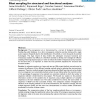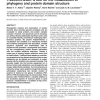59 search results - page 10 / 12 » Mutual Information Content of Homologous DNA Sequences |
BMCBI
2007
13 years 7 months ago
2007
Background: The post-genomic era is characterised by a torrent of biological information flooding the public databases. As a direct consequence, similarity searches starting with ...
NAR
2006
13 years 7 months ago
2006
Phylogenetic analysis and examination of protein domains allow accurate genome annotation and are invaluable to study proteins and protein complex evolution. However, two sequence...
BMCBI
2008
13 years 7 months ago
2008
Background: Protein domains are the structural and functional units of proteins. The ability to parse proteins into different domains is important for effective classification, un...
BMCBI
2006
13 years 7 months ago
2006
Background: Many dimeric protein complexes bind cooperatively to families of bipartite nucleic acid sequence elements, which consist of pairs of conserved half-site sequences sepa...
JCB
2002
13 years 7 months ago
2002
At least 43% of the human genome is occupied by repetitive elements. Moreover, around 51% of the rice genome is occupied by repetitive elements. The analysis of repetitive element...


